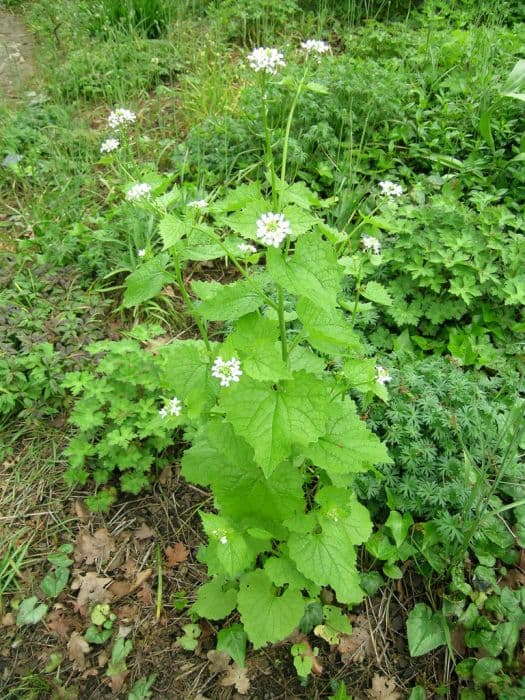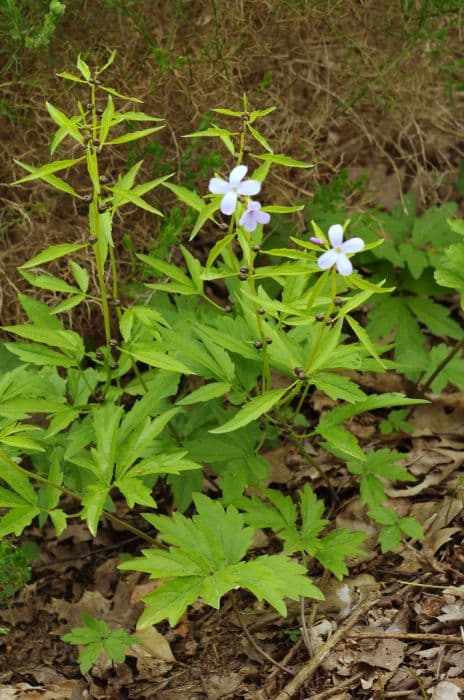Wallflower Erysimum cheiri

ABOUT
The plant known as wallflower is a popular perennial that is cherished for its vibrant and fragrant flowers. It typically displays a robust growth habit, forming clusters of narrow, lance-shaped leaves. These leaves often possess a deep green hue, providing a striking backdrop to the wallflower's most notable feature — its blossoms. As the plant matures, it produces stout spikes of flowers, which can vary in color. The blossoms are commonly seen in a spectrum of warm colors, ranging from bright yellow to deep reds and oranges, as well as in shades of pink and purple. Each individual flower is small to medium in size, with four petals that form a cross shape, a characteristic that adds to its ornamental appeal. The wallflower's blossoms are not only visually striking but also aromatic, emitting a sweet and spicy scent that is particularly strong during the evening. This pleasant fragrance makes it a valuable addition to gardens, attracting pollinators like bees and butterflies. The wallflower's blooming season usually occurs in the spring and can sometimes extend into the summer months, depending on the climate and growing conditions. During this period, the plant can become a focal point in garden beds and borders, bringing a splash of color and scent to the outdoor space. Overall, the wallflower's combination of attractive foliage, vibrant and sweet-scented flowers, and its tendency to form neat clusters without spreading uncontrollably, makes it a beloved choice for gardeners seeking to add long-lasting interest to their landscape.
About this plant
 Names
NamesFamily
Brassicaceae
Synonyms
Wallflower, English Wallflower, Aegean Wallflower, Cheiranthus Cheiri
Common names
Cheiranthus cheiri, Erysimum cheiranthoides, Cheiranthus cheiri var. grandiflorus, Cheiranthus cheiri var. robustus, Erysimum arkansanum, Erysimum perofskianum, Erysimum rhaeticum.
 Toxicity
ToxicityTo humans
Wallflower (Erysimum cheiri) has components that may be toxic if ingested. It contains compounds such as glucosinolates and isothiocyanates, which can cause gastrointestinal distress if consumed in large quantities. Symptoms of poisoning can include nausea, vomiting, diarrhea, and abdominal pain. Ingesting any part of the plant may lead to these toxic effects.
To pets
Wallflower (Erysimum cheiri) is also potentially toxic to pets if ingested. The glucosinolates and isothiocyanates present in the plant can cause vomiting, diarrhea, drooling, and abdominal pain in animals. In severe cases, ingestion can lead to more serious symptoms such as tremors or heart abnormalities. It is important to prevent pets from ingesting any part of the plant to avoid these harmful consequences.
 Characteristics
CharacteristicsLife cycle
Biennials
Foliage type
Evergreen
Color of leaves
Green
Flower color
Varies
Height
1-2 feet (30-60 cm)
Spread
1 foot (30 cm)
Plant type
Herb
Hardiness zones
7
Native area
Mediterranean
Benefits
 General Benefits
General Benefits- Ornamental Value: Erysimum cheiri, commonly known as wallflower, adds aesthetic appeal to gardens with its colorful blooms.
- Long Blooming Season: Wallflowers are known for their extended flowering period, providing color from early spring through late summer in some regions.
- Attracts Pollinators: The bright flowers attract bees, butterflies, and other beneficial pollinators to the garden, supporting local ecosystems.
- Drought Resistance: Once established, Erysimum cheiri is quite drought-tolerant, making it suitable for xeriscaping or low-water gardens.
- Easy to Grow: Wallflower is generally low-maintenance and can thrive in a range of soil types, as long as they are well-drained.
- Suitable for Containers: Its compact growth habit makes it well-suited for container gardening or small spaces.
- Cut Flowers: The fragrant blooms make excellent cut flowers for arrangements.
- Variety of Colors: Wallflower plants come in a variety of colors, allowing for diverse design and planting schemes.
- Cultural Significance: Erysimum cheiri has a rich history in gardening and has been cultivated for centuries, giving it cultural significance.
- Edging and Borders: Due to its size and form, wallflower is ideal for creating edging and borders in landscape design.
- Wildlife Friendly: Providing shelter and food for wildlife, wallflowers can help to create a more biodiverse environment.
 Medical Properties
Medical Properties- Expectorant: Erysimum cheiri, commonly known as Wallflower, has been traditionally used to help loosen phlegm in the respiratory passages.
- Diuretic: It is attributed with diuretic properties, facilitating the removal of excess water from the body.
- Antirheumatic: Some cultures have used Wallflower to relieve symptoms associated with rheumatism.
- Purgative: It has been used historically as a purgative to stimulate bowel movements and relieve constipation.
 Air-purifying Qualities
Air-purifying QualitiesThis plant is not specifically known for air purifying qualities.
 Other Uses
Other Uses- Dye Production: Erysimim cheiri, commonly known as wallflower, has been used historically for obtaining a natural yellow or orange dye used for fabrics.
- Companion Planting: Wallflowers can be used in gardens as companion plants to repel pests and attract beneficial insects, thus protecting other plants.
- Pot-pourri: The dried flowers of wallflower retain their fragrance and can be included in pot-pourri mixes.
- Aromatherapy: The essential oil from the wallflower is sometimes used in aromatherapy for its strong and pleasant fragrance.
- Garden Aesthetics: Wallflowers are often planted in rock gardens, borders, and cottage gardens for their vibrant colors and aesthetic appeal.
- Educational Use: Wallflowers can be used as a subject in botanical studies due to their distinct seed pods and growth habits.
- Culinary Garnish: While not commonly used for consumption, wallflower petals can be used as an ornamental garnish for their color.
- Craft Supplies: Dried wallflower plants can be incorporated into crafts such as wreaths and dried flower arrangements.
- Traditional Celebrations: In some cultures, wallflowers have been used in traditional ceremonies and seasonal celebrations.
- Photography: Wallflowers, with their rich colors, are a popular subject in plant photography, enhancing garden portfolios.
Interesting Facts
 Feng Shui
Feng ShuiWallflower is not used in Feng Shui practice.
 Zodiac Sign Compitability
Zodiac Sign CompitabilityWallflower is not used in astrology practice.
 Plant Symbolism
Plant Symbolism- Survival and Resilience: Erysimum cheiri, commonly known as wallflower, often grows in challenging conditions, such as rocky soils and cliff sides, symbolizing the ability to endure and thrive in tough situations.
- Fidelity and Faithfulness: Wallflowers have historically symbolized loyalty and the steadfastness of affections, likely stemming from their long-lasting blooms.
- Lasting Beauty: With its bright and enduring flowers, the wallflower signifies lasting beauty or the idea that true beauty persists beyond physical attractiveness.
- Adversity: Since wallflowers grow in less than ideal locations, they can also represent life’s struggles or overcoming adversity.
 Water
WaterWallflower plants require moderate watering to maintain moist but not waterlogged soil. During active growth, especially in the spring and summer, water the plant thoroughly once a week using around 1 gallon per watering for a medium-sized plant, allowing water to penetrate the soil deeply. In hotter, drier periods, water twice a week, but always check the soil before watering to ensure it has begun to dry out. Reduce watering in the fall and winter to prevent root rot, providing water every two weeks or less, depending on the weather conditions.
 Light
LightWallflowers thrive in full sun conditions, where they can receive at least 6 hours of direct sunlight per day. The ideal spot for planting wallflowers is an area where they can bask in morning light and be sheltered from intense afternoon heat if located in a very hot climate. Partial shade can be tolerated, but flowering and overall health of the wallflower might not be as robust as when grown in full sun.
 Temperature
TemperatureWallflowers prefer moderate temperatures and are known to be quite hardy. They can withstand temperatures as low as the upper teens in Fahrenheit without significant damage and can survive up to the high 70s to low 80s Fahrenheit during their active growing period. The ideal temperature range for wallflowers to thrive is between the high 40s to mid 60s Fahrenheit.
 Pruning
PruningPrune wallflowers after they have finished blooming to promote bushier growth and encourage a second bloom in the same season. Deadheading spent flowers regularly throughout the growing season can also improve the plant's appearance and vigor. The best time to perform substantial pruning is in late spring or early summer, immediately after the first wave of flowering has concluded.
 Cleaning
CleaningAs needed
 Soil
SoilWallflower thrives in well-draining alkaline soil with pH between 7.0 and 8.0. A mix with garden compost and chalk or grit to enhance drainage is ideal.
 Repotting
RepottingWallflowers are biennials or short-lived perennials and often don't require repotting. Plant new ones every 2-3 years to maintain vigor.
 Humidity & Misting
Humidity & MistingWallflower prefers a dry to average humidity environment; they do not require high humidity and can tolerate dry air conditions well.
 Suitable locations
Suitable locationsIndoor
Place wallflower in a sunny spot indoors with good air circulation.
Outdoor
Plant wallflower in a sunny spot with well-drained soil.
Hardiness zone
5-9 USDA
 Life cycle
Life cycleErysimum cheiri, commonly known as wallflower, begins its life cycle when seeds are sown in well-draining soil and germinate, usually in late spring or early summer. Seedlings emerge and grow into vegetative plants with narrow, green leaves and develop a sturdy root system. As the plant matures, it undergoes vernalization, a process requiring exposure to cold temperatures to initiate flowering, which typically occurs during the second year. In spring, the wallflower produces clusters of fragrant flowers ranging in color from yellow to red, attracting pollinators for reproduction. After pollination, the flowers develop into long, slender seed pods called siliques that release seeds once mature, completing the reproductive phase. The plant is biennial or short-lived perennial and may die after seeding, but some plants can survive and flower for several seasons if conditions allow.
 Propogation
PropogationPropogation time
Spring to summer
The most popular method of propagation for Erysimum cheiri, commonly known as wallflower, is through seeds. Seed propagation is usually done in late spring or early summer. To propagate wallflowers from seed, first, choose a well-draining soil mix and sow the seeds thinly in trays or directly in the ground where they are to grow. Cover the seeds lightly with about 1/8 inch (approximately 3 millimeters) of soil. Maintain consistent moisture but avoid waterlogging as the seeds germinate. It typically takes one to two weeks for wallflower seeds to sprout. Once the seedlings have grown large enough to handle, thin them out or transplant them to their final location, taking care not to overcrowd the plants to encourage good air circulation and healthy growth.








